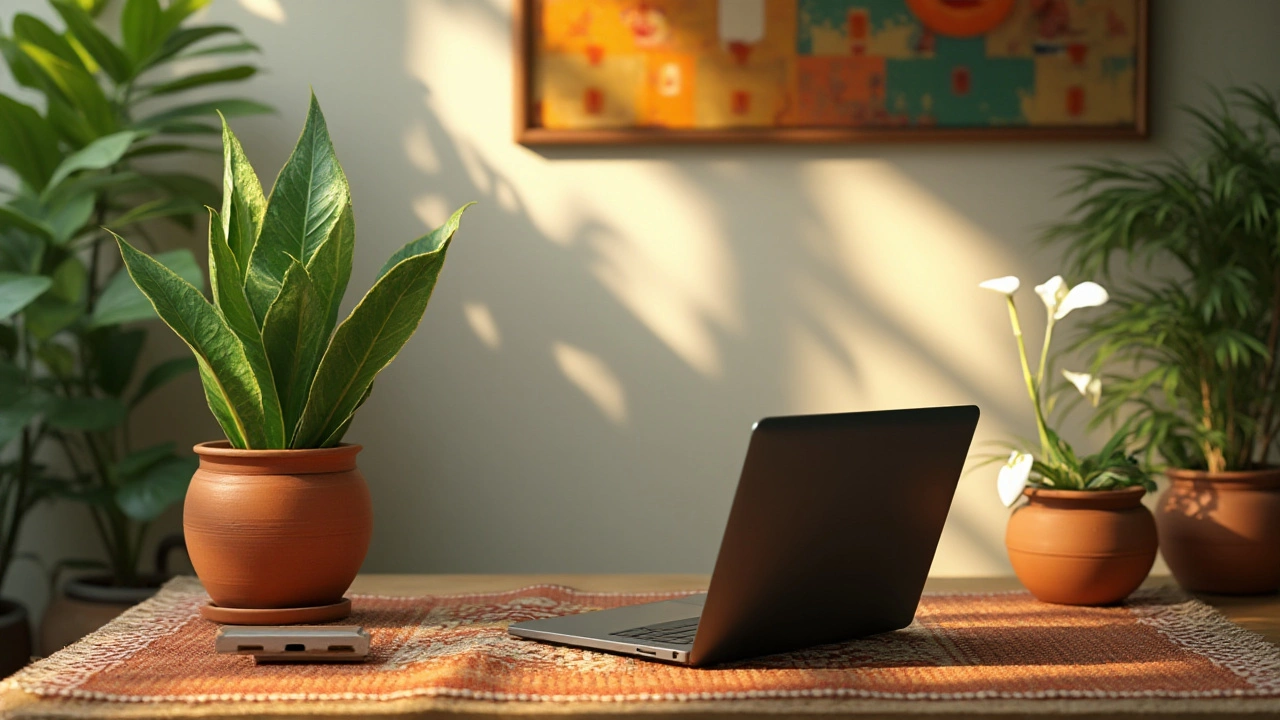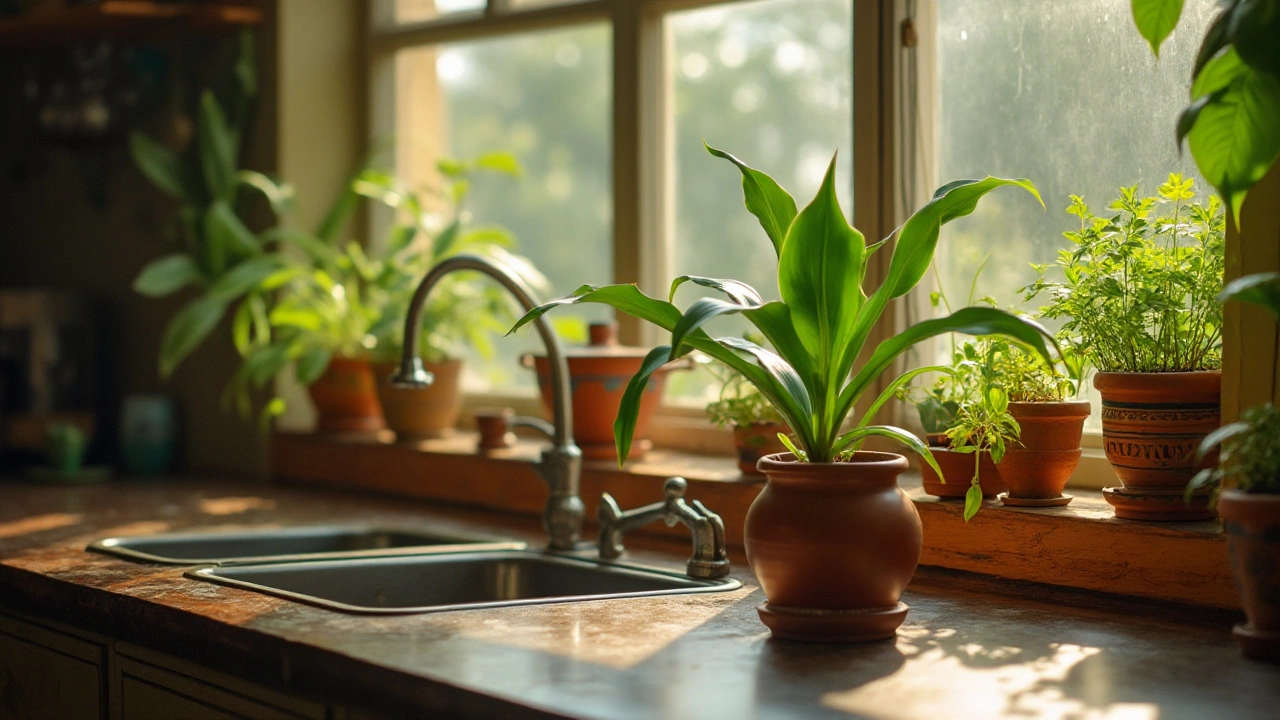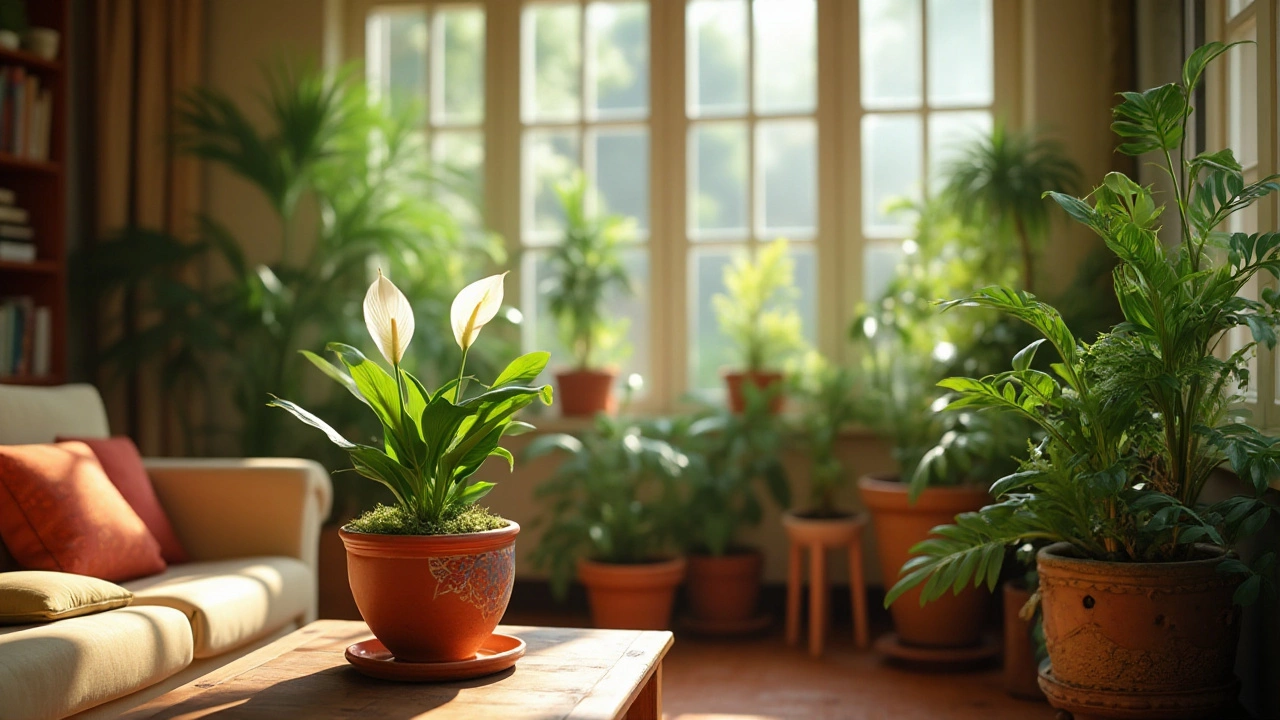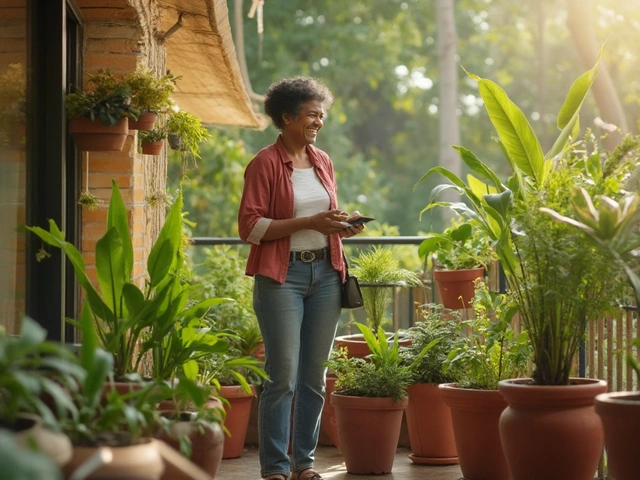In our constant search for healthier living environments, houseplants emerge as silent but powerful allies. These green companions do more than just brighten up a room — they actively work to purify the air around us. Drawing on research and traditional wisdom, let's embark on a journey to explore the best houseplants that clean the air.
You might be surprised to learn how effectively certain plants can remove toxins and pollutants from the indoor atmosphere. They don't just look good; they're nature’s own air purifiers. Whether you're a seasoned plant enthusiast or a curious beginner, this guide will unravel the secrets behind the top air-cleaning houseplants and how to nurture them to their full potential.
- Understanding Air Quality and Its Importance
- Top Houseplants Known for Air Purification
- Benefits of Air-Purifying Plants in Your Home
- Essential Care Tips for Optimal Plant Performance
- Common Mistakes and How to Avoid Them
Understanding Air Quality and Its Importance
When we talk about air quality, we often think of outdoor pollution, from car exhausts to industrial emissions. However, the air inside our homes can be just as contaminated, yet we pay less attention to it. Indoor air quality (IAQ) relates to the air’s healthfulness in an enclosed space, and it’s something every homeowner should be mindful about. Surprisingly, the air inside your home can harbor several pollutants, which may originate from common household items and activities. Everyday sources include cleaning products, building materials, and even the furniture we cherish.
Most of us spend a significant time indoors, whether at work or home, making IAQ a crucial aspect of our lives. Poor air quality can trigger a range of health issues, from minor irritations like itchy eyes and nose to more severe conditions like asthma or other respiratory problems. It’s alarming to note that the Environmental Protection Agency (EPA) ranks indoor air pollution as one of the top environmental risks to public health.
Enhancing air quality within our homes isn’t just an option; it's a necessity. A profound understanding of the air we breathe indoors can pave the way for a healthier lifestyle. There are significant elements like volatile organic compounds (VOCs) — chemicals found in many household products, excessive moisture, and allergens, which stand as the primary culprits degrading our air quality. The air circulation systems in houses, intended to keep us comfortable, sometimes inadvertently lock these pollutants inside, making it crucial to explore ways to mitigate these risks.
"Indoor air pollution can affect you now or years later. It can cause immediate symptoms or have delayed effects, which makes addressing it crucial," - Environmental Protection Agency (EPA).
To effectively manage indoor air, being proactive is vital. One of the ways is introducing houseplants known for their air-purifying qualities. Not only do these indoor plants enhance the aesthetic elbowroom of your living spaces, but they also naturally filter out harmful toxins, providing you with fresher air to breathe. A healthy balance of maintaining other ventilation and cleaning routines, along with leveraging the benefits of these natural purifiers, can orchestrate a symphony of well-being in our daily lives.
Understanding what makes air quality vital involves eliminating factors that reduce air cleanliness and implementing measures that actively improve it. Moving forward, keeping an eye on the everyday choices we make will define the air quality within our spaces. This is where our green allies step in, contributing steadily towards achieving a breathable, pleasant environment. It’s more than a luxury; it’s a pathway to ensuring healthier homes for our loved ones.
Top Houseplants Known for Air Purification
When considering plants that excel in air purification, it's essential to start with the iconic peace lily. This elegant plant, with its lush leaves and striking white flowers, is more than just an eye-pleaser. Renowned for its ability to absorb ammonia, formaldehyde, and benzene, the peace lily transforms your living room into a cleaner, more refreshing haven. It's fascinating how this plant works even when the lights are low, making it ideal for spaces with limited sunlight. To keep a peace lily thriving, ensure it’s placed in a slightly shaded area and watered regularly to maintain moist soil. People often talk about how this plant can even tell you when it’s thirsty by drooping its leaves, a unique feature that endears it to both novice and seasoned plant owners.
The snake plant, or Sansevieria, is another stalwart of indoor air purification. Known for its sword-like leaves, this robust plant can tolerate neglect, making it perfect for busy lifestyles. What makes the snake plant particularly noteworthy is its ability to convert CO2 into oxygen at night, a rare trait shared by few others. This process results in improved air quality while you sleep, and it's one reason many people keep snake plants in their bedrooms. The snake plant is also known to remove toxins like formaldehyde and trichloroethylene from the air. This plant's resilience is legendary, needing only occasional watering and thriving under indirect sun. An additional tip for maintaining its health is to provide good drainage and avoid overwatering, which can cause root rot.
Spider plants, with their easy-going nature and arching foliage, are exceptional at purifying air and adding a retro charm to your decor. What makes spider plants special is their natural ability to fight pollutants like carbon monoxide and xylene, often found in printing materials and rubber. Research has shown that spider plants can reduce these chemicals by up to 90%.
NASA's Clean Air Study famously highlighted the spider plant's effectiveness, suggesting it as one of the top houseplants for improving indoor air quality.These plants are incredibly easy to care for, thriving in indirect sunlight and requiring just weekly watering. They’re also a delight to propagate, as they produce "babies"—small offshoots that can be planted as new starts.
Lastly, the ivy plant, specifically the English ivy, serves as a powerful natural remedy for airborne mold and allergens. Its adaptability allows it to thrive in various indoor climates, significantly reducing mold counts in rooms with poor air circulation. English ivy is versatile and can be grown in hanging baskets or as a climbing plant. Regular misting and indirect light will keep this plant healthy and happy. It's vital to prune your ivy to avoid it becoming unruly, and keeping it out of reach of pets and children is critical, as certain varieties can be toxic if ingested.
Each of these plants brings unique air-purifying qualities to your home, contributing to a healthier living environment. Embrace the natural charm of these plants and enjoy the benefits of cleaner, fresher indoor air. Implementing a variety of these plants in different spaces not only enriches your home aesthetically but also supports a balanced and serene atmosphere for everyone who enters.

Benefits of Air-Purifying Plants in Your Home
The allure of houseplants isn't limited to their aesthetic appeal. They hold an impressive list of benefits, many of which contribute to creating a healthier indoor environment. By reducing toxins and adding oxygen, these plants can transform a dull space into a vibrant oasis of well-being. Imagine walking into a room where the air feels fresh and invigorating, where your senses are gently awakened by the subtle aroma of nature.
One of the primary benefits of air-purifying plants is their natural ability to cleanse the air we breathe. In today's world, indoor air can be more polluted than the air outside due to various toxins released by furniture, paints, and even cleaning supplies. Plants like the peace lily and snake plant are known to absorb these toxins, including formaldehyde, benzene, and trichloroethylene, significantly improving indoor air quality. It's fascinating how nature has equipped these simple organisms with the power to clean and rejuvenate our living spaces.
Beyond just improving air quality, having these plants around can have a profound effect on mental well-being. Studies have shown that being in the presence of nature or natural elements, even indoors, can reduce stress levels, boost mood, and enhance focus. The calming green hues of leaves and the act of caring for living things help foster a sense of tranquility and responsibility.
As Dr. B.C. Wolverton, a former NASA scientist and an authority on air purification, once said, "Plants not only remove carbon dioxide from the atmosphere, but they also eliminate significant amounts of benzene, formaldehyde, and trichloroethylene.”
For allergy sufferers, certain indoor plants can help decrease the levels of airborne dust indoors, easing common allergy symptoms. Though plants naturally release some pollen, by choosing low-pollen species and maintaining a balanced number of plants, you can build a harmonious indoor environment that aids rather than aggravates.
Incorporating air-purifying plants into your home also brings an element of sustainability. Instead of relying on electronic air purifiers, which consume energy, using plants is energy-efficient and eco-friendly. Over time, this simple switch can make a considerable difference in your household's carbon footprint. The natural process by which plants release oxygen and increase humidity can greatly influence your overall health, particularly during the dry months.
To truly harness the full potential of these amazing houseplants, consider forming a mini indoor garden, each plant strategically chosen for its unique qualities. By doing so, not only do you get variety and visual appeal, but also a wider spectrum of benefits, ranging from cleaner air to an uplifted mood.
Essential Care Tips for Optimal Plant Performance
When it comes to ensuring that your air-purifying houseplants thrive, proper care is paramount. These green allies are often hardy, yet certain nuances in their care can greatly enhance their ability to cleanse indoor air. To start, understanding light conditions is crucial. Most indoor plants require indirect light—neither too bright nor too dim. A spot that mimics the dappled sunlight of their natural habitats will suit them best, where direct sunlight can harm the leaves, causing them to scorch or shrivel.
Watering is another critical aspect. Many air-purifying plants prefer their soil to dry out a bit between waterings. The top inch of soil is a good indicator; if it's dry to the touch, it's time to water. Be sure to use room temperature water to avoid shocking the roots. Proper drainage is also vital to prevent water from accumulating at the bottom of the pot, which can lead to root rot. Consider using pots with holes and trays underneath to collect excess water, ensuring your indoor plants remain healthy.
Humidity levels in your home can significantly affect plant health. Most purifying houseplants enjoy a humid environment, akin to tropical rainforests, as it helps them to absorb nutrients efficiently. If your home is particularly dry, especially in winter months, try misting the leaves regularly or placing a humidifier nearby. This additional moisture prevents leaves from browning at the edges and boosts the plant's ability to remove toxins from the air. Grouping plants together can also help maintain a micro-humid climate around them.
Nutrient management is yet another indispensable factor in plant care. Feeding your plants with a balanced, water-soluble fertilizer every two to four weeks during the growing season can dramatically enhance their performance. However, during slower growth periods in winter, reduce feeding frequency, as too much fertilizer can cause nutrient burn. Always follow the recommended doses, as more is not always better. Keeping a little chart or schedule can help manage feeding times effectively over the year.
Pruning is not just for aesthetics; it plays a crucial role in keeping plants vibrant. Regularly trimming dead leaves and spent blooms encourages new growth and helps the plant to focus its energy on healthy foliage. This maintenance can improve a plant’s air-purifying capabilities. It also reduces the risk of disease and pest infestations, as these often take hold in neglected plant areas. Using clean, sharp scissors ensures a clean cut, which heals faster than jagged tears.
According to a study by NASA, houseplants can remove up to 87% of air toxins in just 24 hours. This remarkable fact highlights the importance of maintaining healthy plant conditions for optimal performance.
Finally, don't underestimate the importance of regular rotation. Rotating your plants every few weeks ensures all sides receive equal access to light, fostering balanced growth and full aesthetic appeal. This simple practice can notably enhance a plant’s ability to process light efficiently, maximizing its air-cleaning potential. Monitoring your plants' responses to these care tactics will guide you to make any necessary adjustments, promoting a lush, healthy indoor environment.

Common Mistakes and How to Avoid Them
Even with the best intentions, plant lovers can sometimes run into problems that undermine their efforts to improve indoor air quality. One of the most pervasive mistakes is overwatering. Many assume that more water means a healthier plant, but this can actually suffocate the roots, leading to root rot. This goes for houseplants like the snake plant and spider plant, which prefer drier soil between waterings. To prevent this, always check the moisture level of the soil before watering and ensure that your pots have proper drainage. A good rule of thumb is to wait until the top inch of soil feels dry to the touch before reaching for the watering can.
Another common error is placing plants in the wrong lighting conditions. While some houseplants thrive in bright, indirect light, others might prefer the shade or low-light conditions. It's vital to understand the specific needs of your plant species. Positioning a peace lily, known for its air-purifying prowess, in direct sunlight can cause leaf burn, whereas a spot too shady might stunt its growth. By observing how your plant reacts over a few weeks, you can find the perfect balance of light.
Improper fertilization is yet another snag in achieving a lush indoor oasis. Plants need nutrients, but too much fertilizer can lead to a buildup of salts and chemicals in the soil, damaging the plant’s roots. Conversely, insufficient fertilization can leave plants weak and unable to perform essential functions like air purification. Fertilize during the growing season, using half-strength liquid fertilizer every month or so. It's critical to remember that indoor plants typically require less fertilizer than their outdoor counterparts, so moderation is key.
Pests can also be a hidden challenge. Many novices mistakenly believe their indoor plants are immune to bugs. While houseplants like the spider plant boast pest-resistant properties, tiny invaders like aphids or spider mites can still appear. Regularly inspect your plants for signs of infestations, like sticky residues or discolored leaves, and act quickly to mitigate any outbreaks. Natural remedies such as neem oil can provide effective control without harsh chemicals.
Lastly, neglecting to dust off plant leaves is a misstep that often goes unnoticed. Dust accumulation on leaves can block sunlight and reduce the plant's ability to photosynthesize efficiently, directly affecting its air-purifying abilities. Regularly wiping the leaves with a damp cloth not only keeps them looking vibrant but ensures they are working to their full potential. As environmental scientist Dr. Jane Goodwin points out,
"Keeping leaves clean is like breathing easy for the plant. When we help them, they help us back."





